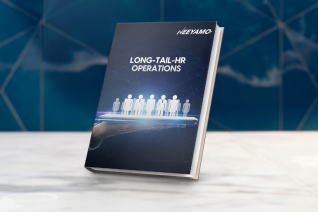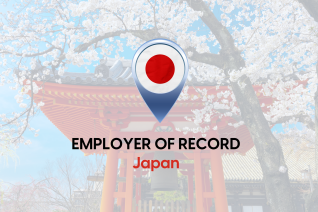Establish your presence globally with Neeyamo as we help you go beyond borders to manage your international payroll and hire new talent in Japan.
Overview
Aside from boasting the world's most populated city, Japan is an enticing business destination due to its stable economy, advanced technology, skilled workforce, and reputation for quality. The government supports foreign investments, and its strategic location in Asia offers access to a vast market. Cultural factors, such as a strong work ethic and commitment to long-term relationships, enhance the business environment.
Neeyamo provides assistance for the onboarding and management of employees in Japan along with the processing of a firm's payroll, compliance, benefits, and more.
Our Presence
Tools And Instances
Facts And Stats
Capital
Tokyo
Currency
Yen (JPY)
Official Language
Japanese
Fiscal Year
1 April - 31 March
Date Format
YYYY/MM/DD
Country Calling Code
+81
Time Zone
UTC +9
Global Payroll
Overview
How does Payroll work? / What is Payroll?
Payroll means the list of compensation to be paid to employees of a company or organization for a set period or date.
Handling payroll for a widespread workforce can pose a significant challenge for any organization, and the added complication of compliance can worsen things. If companies spend more time processing payroll, it directly impacts day-to-day operations and their overall productivity. The solution to this problem is a Global Payroll Outsourcing company.
Over the years, Neeyamo has observed these complexities and strived to provide a global payroll solution through a single technology platform - Neeyamo Payroll. Neeyamos global payroll services ease the process for companies looking to outsource their global payroll requirements and aid them in maneuvering payroll in Japan. Neeyamos payroll providers have the perfect solution for all your global payroll needs – for employees working in primary geographies, the long-tail region, remote or internationally located.
Payroll Taxes
Payroll tax is the percentage amount retained from an employee's salary and paid to the government to invest in the general population's welfare. These are statutory in nature and are levied from both the employer and employee. Additional statutory contributions are made by employers toward providing both short-term and long-term benefits for their employees.
How to calculate payroll taxes?
Neeyamo acts as your personalized Payroll Calculator. Ensuring adherence to local regulatory requirements using multi-level controls. Providing timely and accurate payroll, courtesy of our experts worldwide and using a tech-based integrated smart helpdesk solution with seamless support experience manned by payroll experts - Neeyamo covers all your payroll needs.
Employee Taxes
- Pension Contribution: 9.15%
- Unemployment Insurance: 0.55%
- Nursing Care Insurance: 0.795%
- Health Insurance: 4.955%
- Specific rates of Health Insurance for other prefectures are provided at
https://www.kyoukaikenpo.or.jp/g7/cat330/sb3130/r07/250214/
Employee Income Tax
| Percentage | Income Bracket |
|---|---|
| 5.00% | Up to 1.95M JPY |
| 10.00% | 1.95M - 3.3M JPY |
| 20.00% | 3.3M - 6.95M JPY |
| 23.00% | 6.95M - 9M JPY |
| 33.00% | 9M - 18M JPY |
| 40.00% | 18M - 40M JPY |
| 45.00% | Over 40M JPY |
Basic Deduction Review
|
Total Income |
Previous Basic Deduction |
For 2026 |
For 2027 |
|---|---|---|---|
|
Up to 1.32M JPY |
480,000 JPY |
950,000 JPY |
950,000 JPY |
|
1.32M JPY to 3.36M JPY |
480,000 JPY |
880,000 JPY |
580,000 JPY |
|
3.36M JPY to 4.89M JPY |
480,000 JPY |
680,000 JPY |
580,000 JPY |
|
4.89M JPY to 6.55M JPY |
480,000 JPY |
630,000 JPY |
580,000 JPY |
|
6.55M JPY to 23.6M JPY |
480,000 JPY |
580,000 JPY |
A flat deduction amount |
|
Over 23.6M JPY |
Unchanged |
Unchanged |
Unchanged |
The minimum guaranteed employment income deduction has been increased to 650,000 JPY, up from 550,000 JPY. This change will be reflected in the 2026 withholding tax tables and the 2025 year-end adjustment tables.
A new deduction of up to 630,000 JPY per eligible relative is being introduced for residents. This new deduction takes effect in January 2026.
Revised Income Requirements for Dependents
|
Dependent Category |
Previous Total Income Requirement |
New Total Income Requirement |
|---|---|---|
|
Dependents & Spouses |
480,000 JPY or less |
580,000 JPY or less |
|
Children of a Single Parent |
480,000 JPY or less |
580,000 JPY or less |
|
Working Students |
750,000 JPY or less |
850,000 JPY or less |
Employer Taxes
- Pension Contribution: 9.15%
- Unemployment Insurance: 0.9%
- Nursing Care Insurance: 0.795%
- Health Insurance: 4.9955%
- Child Allowance: 0.36%
- Worker Injuries Insurance: 0.30%
- Specific rates of Health Insurance for other prefectures are provided at
https://www.kyoukaikenpo.or.jp/g7/cat330/sb3130/r07/250214/
Payroll Cycle
Overview
Undoubtedly, payroll is a critical process for any organization.The pay cycle in Japan refers to the period for which an organization pays its employees, and this can vary depending on the pay frequency that the organization chooses to adopt.
Frequency
In Japan, payments are made monthly typically by the 25th.
13th Month Cycle
A "13th month" or even a "14th-month" paycheck is typically paid in Japan as a summer bonus in June and a winter bonus in December. Japan has a customary 13th or 14th-month bonus payment. The company is free to decide whether to pay the bonus or not. The same applies to Part-time and full-time workers.
Global Work
Overview
An Employer of Record (EOR) service provider helps you eliminate the hassle of handling complexities while onboarding a new employee in an international location. They help bridge the gap that otherwise mandates organizations to have a local registered entity and a local bank account, prior to making a job offer to an international hire.
An EOR service provider acts as a legal employer, facilitates salary payments, and manages other statutory requirements such as health insurance, payroll taxes, and employee benefits ensuring compliance with local tax laws and regulations.
This allows organizations to focus on collaborating with the employee in Japan for operational tasks, with the knowledge that they have a cost-effective solution to support their global payroll & HR requirements, as they continue their global expansion.
Neeyamo strives to provide its customers with a seamless employee management experience and offers employer of record as well as global payroll compliance services with our Global Payroll Technology Stack.
HR Mandates and Practices
Minimum Wage
- Effective November 1, 2024, the minimum hourly wage will increase to Yen 1,055, exceeding the Yen 51 increase proposed by the subcommittee of the Central Minimum Wages Council.
- The highest hourly minimum wage will be in Tokyo at Yen1,163. In the Kanagawa prefecture, the hourly minimum wage will be Yen 1,162, while the lowest hourly minimum wage will be in Akita, Yen 951.
- Effective October 16, 2025, the minimum wage in Osaka Prefecture, Japan, will be revised to Yen 1,177 per hour. This marks an increase of Yen 63 from the previous rate of Yen 1,114.
Overtime
If employees work over 40 hours a week, the company is expected to pay overtime to employees unless they work in a management position. Companies that intend to use overtime on a regular basis should put in place a written agreement between employees and management, commonly called “article 36″ and submit it to Labor Standards Inspection Office. This agreement is often called “Article 36″ because it refers to Article 36 of the Japanese Labor Law. This report should be renewed every year.
Limits of overtime hours in Japan
The overtime hours should stay within the following limits in Japan:
- 5 hours per day
- 45 hours per month
- 360 hours per year
Extra wages for overtime labor are typically paid at a rate of 25% under the Labor Standards Act. To reduce long working hours, the rate of overtime paid for labor exceeding 60 hours per month has been fixed at 50% for large companies since April 2010. This rate has been delayed for small and medium-sized businesses until now, but it will eventually go into force on April 1, 2023.
Data Retention Policy
Japan does not specify how long records must be kept.
Generally, taxpayers must maintain books and records in case they are subject to inspection by tax authorities.
Japan does not provide the length of time in which records must be kept.
Employers in Japan must maintain records regarding compensation and benefits provided to employees.
Hiring and Onboarding Requirements
Hiring
The following terms must be expressly stated in writing when concluding an employment contract, regardless of whether it is verbal or written:
- length of service;
- employment information, including job description;
- start and end times, extra hours, rest periods, vacation days, and shift changes;
- the decision, computation, and payment of wages (apart from special wages and retirement benefits); and
- rules and processes for leaving and resigning (including grounds for dismissal).
Onboarding
A person who is hired as an employee is required to submit the following documents during onboarding:
- Resumé
- Certificate of items stated in the resident register;
- Copy of Driver's Licence (for those who have a driver's license);
- Copy of Certificates of qualifications (for those who have certificates of qualifications);
- Other documents specified by the company
In the event that any changes occur in any documents after submission, the employee must immediately notify of such changes to the company in written form.
Probation
Under the Labour Standards Act of 1947 article 20, an employer must usually give 30 days' notice before dismissal, or pay in lieu of notice. An employee is permitted to resign at any time (usually two weeks' notice is required).
For permanent employees, the probationary period in Japan typically lasts between three and six months.
In Japan, it is common practice to set a probationary period of three to six months for new hires, effective from the hiring date. The workflow for the probationary period is up to each company to decide; it is common to define the tasks to be done before onboarding and have the employees comply with such tasks that you want during Onboarding and have them perform them based on those tasks.
Leave
Public Holidays
National Holidays
The following national holidays are observed in Japan
- Jan 1 and Jan 2: New Year's Day
- Jan 9: Coming of Age Day
- Feb 11: National Foundation Day
- Feb 23: Emperor's Birthday
- Mar 21: Vernal Equinox
- Apr 29: Showa Day
- May 3: Constitution Memorial Day
- May 4: Greenery Day
- May 5: Children's Day
- Jul 17: Marine Day
- Aug 11: Mountain Day
- Sept 18: Respect for the Aged Day
- Sept 23: Autumnal Equinox
- Oct 9: Health and Sports Day
- Nov 3: Culture Day
- Nov 23: Labor Thanksgiving Day
Sick Leave
Despite the fact that there is no regulation governing sick or disability leave resulting from work, many businesses have their own policies addressing sick leave and/or compensation for times when they are ill.
Maternity Leave
According to the Child Care and Nursing Care Act, a pregnant employee may take up to six weeks (or 14 weeks in the event of multiple fetuses) of maternity leave before giving birth and eight weeks after doing so. Additionally, an employer cannot require a woman to work within eight weeks of giving birth. However, if such a woman has made the request to return to work, this Act shall not prevent an employer from granting her request, provided that six weeks have passed since the woman gave birth and the work activities to be performed are those that a doctor has approved as having no adverse effect on her. During maternity, the company is not required to pay the employee.
Parental Leave
A worker (of either gender) who has worked for the company for at least a year is eligible to take child care leave for a kid under the age of one (or until the child becomes one year and two months old, one and a half years old, or two years old). This is dependent on specific circumstances and excludes some workers, such as those with fixed-term contracts that end when the kid becomes one and a half years old. During parental leave, the company is not required to pay the employee.
Annual Leave
Depending on the employee's term of continuous work, the statutory minimum amount of paid yearly leave varies:
- 6 months of service = 10 days of paid annual leave
- 1 year and 6 months = 11 days
- 2 years and 6 months = 12 days
- 3 years and 6 months = 14 days
- 4 years and 6 months = 16 days
- 5 years and 6 months = 18 days
- 6 years and 6 months or more = 20 days
Nursing Care Leave
A worker who has worked for at least a year and is caring for a family member who needs nursing is allowed to take 93 days of leave altogether for each family member under the Child Care and Nursing Care Act. This excludes some employees, such as those with fixed-term employment contracts, whose employment would expire within six months and 93 days of the nursing care leave's scheduled start date. Additionally, the employee is not entitled to compensation while on nursing care leave.
Child Care Leave / Paternity Leave
The employee is also entitled to leave in order to care for a family member according to the Child Care and Family Care Leave Act. The family member, who might be the spouse, the child, the parents or even the grand-parents, needs to be in a condition requiring continuous care (Art. 2). Such leave must not exceed three months and can, except for certain circumstances, be exercised only once per person (Arts. 15 and 11). The employee does not get any payment during this period.
Postnatal Leave
Effective April 1, 2025, amendments to the Employment Insurance Act have introduced a new Postnatal Leave Support Benefit, aimed at promoting co-parenting and assisting dual-income households during the early stages of parenthood.
Key Highlights
- Leave Duration: Up to 28 days of paid leave is available to eligible parents.
- This benefit is in addition to the existing Childcare Leave Benefit.
- To qualify, both parents must take at least 14 days of childcare leave after the child’s birth or expected birth date.
- Benefit Amount: Equivalent to 80% of the daily wage, calculated as: Salary × Number of leave days × 13%
- Based on the average daily wage from the 6 months preceding the leave.
Expanded Family Care Leave
Employees with children up to the third year of primary school can take leave for childcare purposes, including attending to illness and participating in school events, irrespective of their length of service.
Termination
Overview
The following are examples of typical grounds for termination:
- an employee's inability to provide labor due to injury, disability, illness, or permanent damage;
- significantly poor performance;
- breach of work responsibilities and duties, orders, or workplace disciplines, policies, and internal rules; and
- loss of job responsibility, redundancy due to business downsizing, or economic; Every reason for termination must be specified in the work regulations or the employment contract.
Under the Labour Standards Act of 1947 article 20, an employer must usually give 30 days' notice before dismissal, or pay in lieu of notice. An employee is permitted to resign at any time (usually two weeks' notice is required).
Notice Period
Collective agreements may contain provisions on notice periods. If notice periods in the collective agreement differ from the statutory notice periods, the employer and the employee observe the notice periods in the collective agreement. The amount of notice is dependent on the function of the employee and the length of service, if the employer terminates the contract, the notice period is as follows:
- For the executives, working less than one year is counted as a notice of one month. Employees working for one year to five years are counted as a notice of 2 months.
- Employees working for more than five years have counted a notice of three months.
- Employees working less than one year give eight days' notice.
- Employees with one year to five years give one month's notice.
- Employees working for more than five years give two months' notice.
If the employer terminates the contract, notice is not required in cases of serious misconduct.
Severance Pay
Under Japanese law, there is no statutory obligation to pay severance allowance upon termination, except in circumstances when payment is in lieu of notice.
Visa
Overview
To be eligible to apply for a long-term visa, an employee from another country must first receive a Certificate of Eligibility (COE). A COE is a legal document that the Japanese Ministry of Justice issues. A sponsor in Japan is necessary in order to receive the COE. Sponsors might be family, coworkers, or institutions.
Any form of work visa that is authorized to stay in Japan for a regular length of five years, three years, one year, or three months may be granted a long-term visa under Japanese law. An outside-of-Japan employee who will soon be relocated to the company's Japanese office for a brief period of time may qualify for a work visa under the category of the intra-company transferee.
The application process for applying for a Work Visa for Japan is:
- Getting a Certificate of Eligibility
- Applying for a Japan Work Visa
Every foreigner who enters Japan for long-term purposes needs to get a Certificate of Eligibility from the Immigration Services in Japan.
After you receive the Certificate of Eligibility, your employer must send it to you so you can use it to apply for the Work Visa from a Japanese Diplomatic Representative Office.
Japan has close to 30 different work permits and long-term visas based on an expatriate’s job and reason for moving to Japan. There are specific work visas for occupation, including options for artists, instructors, journalists, professors, skilled laborers, and more. The type of permit an employee applies for will determine how long they can remain in Japan. Typically, the length ranges from three months to five years.
Types of Visa
In addition to the work permits for occupations, Japan recently introduced specific skills visas, including:
- Specified Skilled Worker Visa: This visa is for foreign workers coming to Japan to fill employment gaps in certain labor sectors. Japan hopes it will bring approximately 500,000 new foreign workers to the country by 2025.
- Specified Skills Visa 1-SSV1: Only skilled workers in specific industries, such as shipbuilding, agriculture, nursing care, and some others, can apply for this visa. It requires Japanese language tests and technical exams. The visa is valid for one year and renewable for up to five years. If an applicant wants to stay longer than five years, they will need to apply for visa 2-SSV2.
- Specified Skills Visa 2-SSV2: Applicants can renew this visa indefinitely and bring their family members to Japan. Individuals currently living and working in Japan under a Visa 1-SSV1 can apply for this specific visa only after they get a higher level of specialization in their field.
Employee Background Checks
Legal and Background Checks
Background checks are not constrained by law in Japan. However, certain information has to be handled carefully based on the sensitivity of the data. According to the 2003 Act on the Protection of Personal Information, it is generally prohibited to collect sensitive personal information about applicants without their consent. This includes information about their race, religion, social status, medical history, criminal history, and whether or not they have been the victim of crime.
It is also customary to request a medical exam and a statement of any criminal histories. These delicate data must be gathered in a way that is socially acceptable and safely stored.
In Japan, the employer cannot conduct background checks on the employee as it may lead to employment discrimination. Background checks may be done only after getting consent/approval individually from the employees. The company cannot force the employees to provide consent/approval. Referrals from previous employers cannot be done without obtaining consent/approval from the employee either.
Therefore, it is not possible to terminate or cancel the employment contract on this basis.
Last updated on September 15, 2025
If you have any queries or suggestions, reach out to us at irene.jones@neeyamo.com
Have Queries? Get In Touch With Us
Get in touch with one of our experts and take a quick demo of our services













